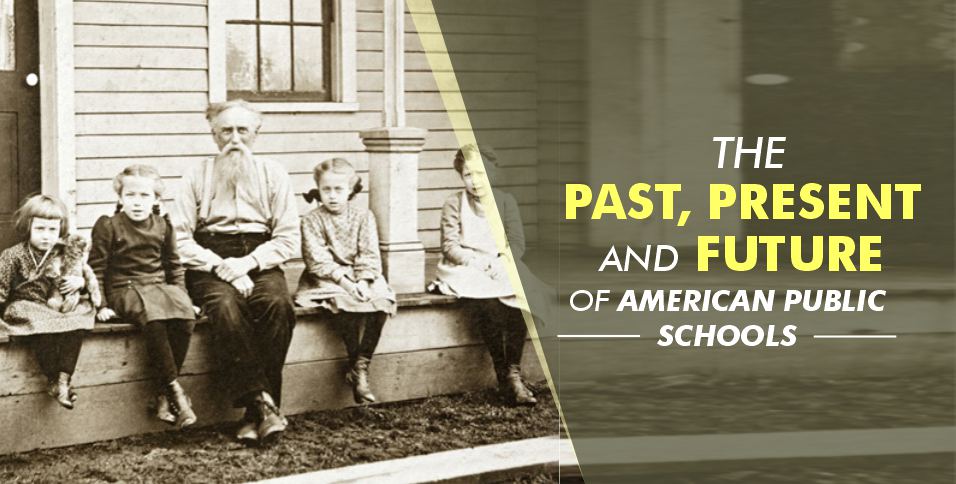Politicians, educators, parents and students consistently bemoan the quality of American public schools, asserting that classrooms just aren’t what they used to be. But — what did public schools used to be? Like so much of American culture, the history of public education in the U.S. is often viewed through rose-colored glasses, and an examination of the true progress of public schools in America should give every participant in the school system more hope for the future.
The Origins of American Public Schools
When European settlers first began colonizing the New World, they did not bring with them any formal system for public education. In the 17th and 18th centuries, education was extremely limited, available only to the wealthiest, land-owning white families who could hire and house a high-quality tutor to teach their sons (and, to a lesser extent, their daughters). Though there were some private institutions for education, like church-supported schools and boarding schools, they tended to be even more expensive and thus exceedingly exclusive. Charity schools for poor children were few and far between.
Fortunately, the Founding Fathers believed in the power of education for improving democracy. Because democracy is only as effective as the intelligence and compassion of the people, early leaders like Thomas Jefferson and John Adams proposed a unified system of publicly funded schools. Federal initiatives for creating school systems in nascent states as well as the emerging “common school” movement saw the widespread adoption of public education across the country by the 1830s.
The Origins of Evaluating Public School Performance
An open public school is not the same as an effective public school. By the end of the 19th century, school administrators and lawmakers were eager to understand the strengths and weaknesses of existing schools and bring coherence to the system that until that point was a hodgepodge of local regulations.
In 1893, the Committee of Ten became the first of countless commissions to examine American education — and what they found would set a longstanding precedent for disappointment regarding public schools in the U.S. At the time, more than 3 million American children were eligible for public secondary education, but only just over 200 thousand were enrolled. Of them, most were woefully unprepared for the classroom, barely equipped with basic arithmetic or any grasp of science. As a result, funding for secondary education expanded, but the system continued to be plagued by various issues.
20th Century Public School Progress
Throughout the first half of the 20th century, public schools slowly but surely improved, in terms of their enrollment numbers, graduation rates and breadth of knowledge and skill passed to students. Still, a large number of Americans continued to complain. Though no one yet claimed that education was better in a previous age, most grumbled about the rampant inefficiency of the public school system, which demanded an overwhelming amount of funding but seemed to generate little public good.
Following World War II, the failings of America’s schools became a primary focus for critics, who began to recall previous eras when students were supposedly better served by the nation’s educators. The Cold War created increased pressure on the public school system to produce students who were the smartest, fastest, strongest and best in the world. Around the same time, Civil Rights movements eliminated segregation and pushed for improved equity and opportunity for all. Yet, still suffering from a reputation of inefficiency, public school systems around the country failed to gain any noticeable increase in funding to meet these new expectations.

For the rest of the 20th century and the beginning of the 21st, schools have become the scapegoat for everything that America is doing wrong. Weak national security, poor economic growth, slow social progress, lagging scientific discovery — all because the public schools are failing our nation’s youth. Yet, every assessment of the education system has found a startling truth: Students of today’s schools are much more successful in every way than students of yesterday.
The Public School Systems of the Future
That public school education has consistently improved from its inception is great news for the future of schools and students — but the future is never certain. Schools and students need the American public to continue caring about the public education system, which involves supporting lawmakers who prioritize funding and regulation of public schools. Additionally, educators must continue to improve, using PhDs in Education to better understand the most effective methods for imparting knowledge and skill to students. With concerted effort, the American public education system can reach the high expectations of the public and continue to support our powerful and famous democracy.
American public schools are not what they used to be — they are much, much better. And through the use of research and advanced technology, they can continue delivering high-quality education to the nation’s students into the future.
Also Read: Are International Schools Justified In Charging Higher Fees: A Critical Assessment















